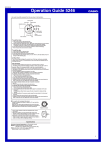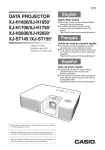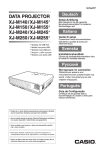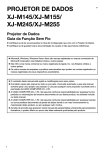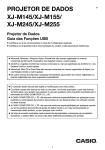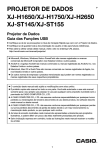Transcript
MA1202-EA Ú#!3)/#/-054%2#/,4$ Operation Guide 5275 Your watch may differ somewhat from the one shown in the illustration. Solar Charging Before Using the Watch for the First Time Depending on your watch model, there may be a spacer installed at the factory around the crown. If your watch has a spacer, you should remove the spacer before using the watch. After removing the spacer, use the procedures in “Crown Operations” and “To adjust the time setting” to set up the watch for use. Spacer A solar panel generates electrical power that charges a built-in (secondary) battery. The entire face is a solar panel, so power is generated when the face is exposed to light. Keep the watch exposed to light as much as possible. Charging the Battery Crown When you are not wearing the watch, leave it where it is exposed to light. For stable operation, expose the watch to at least a half day of light per month. Click 2 Click 1 When wearing the watch, try to keep your clothing from blocking its face (solar panel). Charging efficiency is reduced significantly even if the face is blocked only partially. Crown Caution! To adjust the time setting When the second hand is at 12 o’clock, pull the Crown out to Click 2. Rotate the Crown to change the time setting. Note When changing the time, move the minute hand four or five minutes past your final setting, and then back it up to the setting you want. The case of the watch may become quite hot when charging. Guard against burn injury after charging. Avoid charging in the following locations, and anywhere else where the watch may become very hot. − On the dashboard of an automobile parked in the sun − Close to an incandescent light source or other sources of heat − Locations exposed to direct sunlight for long periods Low Charge and Dead Battery Conditions An alert operation is performed when the battery charge goes low. Low Battery Alert The second hand will jump at two-second intervals to alert you when the charge is low. Push the Crown back in. Regular Timekeeping Low Battery Alert Low charge To change the day setting Note Pull the Crown out to Click 1. Rotate the Crown to set the day. Push the Crown back in. Charged The day setting uses a 31-day month. Make adjustments for months of shorter lengths. Avoid changing the day setting between the hours of 9 p.m. and 1 a.m. Otherwise, the day may not change correctly at midnight. Crown Operations Some water-resistant models (100 meters, 200 meters) have a screw-in crown. When you need to perform a crown operation, rotate it towards you to unscrew it. Then pull the crown out. Avoid applying undue force when pulling. The watch loses its water resistance while the crown is unscrewed. After performing a crown operation, fully screw the crown back in. Crown 2-second jump Charging Time The times below are general guidelines for reference only. Charging Time to Support Daily Use Exposure Level (Brightness) 8 minutes Sunlight through a window (10,000 lux) 30 minutes Daylight through a window on an overcast day (5,000 lux) 48 minutes Indoor fluorescent lighting (500 lux) Exposure Level (Brightness) Start Elapsed time Current 8 hours Charging Time to Recover from Dead Battery Loosen If your watch has a rotary bezel... You can rotate the bezel to align its ▼ mark with the minute hand. Then you will be able to tell how much time has elapsed since aligning the ▼ mark. Approximate Charging Time Outdoor sunlight (50,000 lux) Approximate Charging Time to 1-second Hand Movement Approximate Time to Full Charge Outdoor sunlight (50,000 lux) 6 hours 29 hours Sunlight through a window (10,000 lux) 21 hours 108 hours Daylight through a window on an overcast day (5,000 lux) 33 hours 172 hours Indoor fluorescent lighting (500 lux) 329 hours – – – Specifications Accuracy: ±20 seconds average per month Other: Low battery alert Power Supply: Solar panel and one rechargeable battery Approximate battery operating time: 8 months Important! The watch will continue to run for about eight months after a full charge, even if it is not exposed to light. For stable operation, however, expose it to light as much as possible. Note Actual charging time depends on environmental conditions. Over-charge Protection Charging stops automatically when a full charge is attained. This protects against over-charging. 1

